A group of Mayo Clinic Volunteers – Mayo Foundation for Medical Education and Research
I recently accompanied a friend to Mayo Clinic in Rochester, MN, for a week. While my friend was going through testing, I was observing the campus and asking questions to patients, Mayo employees, volunteers, family members, and employees of companies surrounding the clinic.
The experience was transformational in my life, especially in three areas of my passion — culture, change, and caregiving.
What I Learned About Culture
There are many definitions and interpretations of culture. One widely recognized definition comes from famed Anthropologist Ralph Linton:
“Culture is the way of life of its members: the collection of ideas and habits which they learn, share and transmit from generation to generation.”
There are the definitions of culture and then there is the embodiment of culture. We experienced the Mayo Clinic culture in action multiple times throughout the week. The mission, vision, and values of Mayo are so clearly understood and embraced by its employees, volunteers, patients, families, and community, that it has a name: “Mayo Nice”.
|
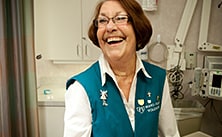 |
Before knowing it by name, my friend had experienced it throughout the scheduling and planning process with the Mayo team. She felt confident and had peace of mind as we headed out on our journey.
My first experience with “Mayo Nice” was on our flight to Rochester. During our conversation, my seat mate, Sarah (names have been changed for privacy), explained she is an employee of Mayo and has been working there for eight years.
I asked her what her role is. I was so impressed I wrote it down. With great pride, Sarah explained: “I am responsible for making sure research brings cures for diseases.” That sounded fascinating and I asked her to share more about what she does. “My making sure the mice and rats are healthy and well cared for makes it possible for us to support valuable research that finds cures for diseases.”
The mission of Mayo Clinic:
Inspiring hope and promoting health through integrated clinical practice, education and research.
The vision of Mayo Clinic:
Transforming medicine to connect and cure as the global authority in the care of serious or complex disease.
Sarah didn’t have a job feeding mice and rats. From the way she explained her role, she knew she was part of something important in our world.
Imagine if everyone working felt that connected to the value they bring!
Sarah had been out of town for a week. During our conversation she mentioned when we landed she was going home to unpack, go to the grocery store, play with her pets and prepare her meals for the next day — a lot to do after a week away. Before our flight landed, Sarah asked how we were going to get to our hotel. We explained we were going to get an Uber. She said: “You’ve had a long day of travel and will want to be well-rested for your day tomorrow. Please let me give you a ride to your hotel — I go right past it on my way home.” With everything she had to do when she got home, she thought of us and our comfort.
The primary value of Mayo Clinic:
The needs of the patient come first.
We were practically in awe of Sarah’s kindness and generosity — not knowing intentional kindness and thoughtfulness would be the norm for the rest of our visit.
Another example of the embodiment came from the Mayo Clinic volunteers. Once we entered the clinic building there were volunteers everywhere. Holding doors for the elevators, standing at intersections and doorways, playing the piano, at information desks and welcome desks. I noticed they wore star shaped lapel pins — some volunteers wore several pins of different colors.
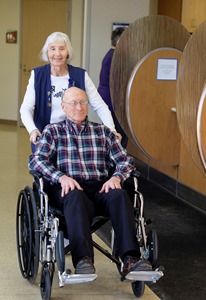
Mayo places volunteers in 18 service areas
I asked a volunteer who was wearing three different pins what each one meant. She explained they are for the number of volunteer hours. She showed me her pins and explained one was for 100 hours, one was for 300 hours and the other was for 500 hours.
Smiling, she said she was still 300 hours behind her husband!
And then there was John. One morning we went to one of the Mayo Clinic hospitals. After getting checked in, I sat in the main reception area and observed people coming into the hospital and being guided to where they needed to be. One of the volunteers, John, stood at the side of the entry to the reception area. If someone coming in so much as paused and looked one way or another, John went to them. One benefit of not hearing a conversation is you can observe the body language. John smiled at each person as he approached them, said something that brought a smile to their face, and obviously asked if he could help them. Individual by individual and couple by couple, faces moved from uncertainty to nods and smiles as he calmly guided them where they needed to go — often walking with them down one of the many hallways.
During a lull in visitors I walked over to where John and fellow volunteer Francie stood. I noticed that unlike many of the volunteers, John wore only one lapel pin. “What do you enjoy most about volunteering?” I asked. John replied: “It makes a difference. It gives people peace of mind.” As I had all the other volunteers, I asked these two how long they’d been volunteering. Francie smiled, replying she’d been volunteering at Mayo for nearly twenty years and then, turning to John, she said and John’s been volunteering for two hours/week for more than thirty years.
During a lull in visitors I walked over to where John and fellow volunteer Francie stood. I noticed that unlike many of the volunteers, John wore only one lapel pin. “What do you enjoy most about volunteering?” I asked. John replied: “It makes a difference. It gives people peace of mind.” As I had all the other volunteers, I asked these two how long they’d been volunteering. Francie smiled, replying she’d been volunteering at Mayo for nearly twenty years and then, turning to John, she said and John’s been volunteering for two hours/week for more than thirty years.
Of course I did the math! That’s approximately 1564 weeks at 2 hours/week for thirty years — 3,128 hours. Even going with 3,000 hours — that’s impressive. After our conversation ended, I researched Mayo volunteers and their pins.
I first learned that while the number of hours John has volunteered is impressive, according to Jennifer Loew, Director of Volunteer Services for Mayo Clinic, “Some people have donated over 10,000 hours.”
I smiled when I found the next set of information — benefits of volunteering. The number 1 benefit: “Make a difference”.
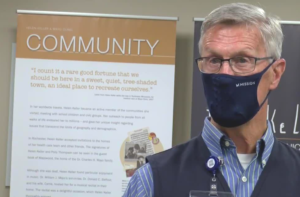
The last benefit also spoke to the culture of Mayo. There is no confusion for the volunteers that they are important to the Mayo mission! Their responsibilities:
- Make a difference
- Be of service to others
- Have fun
- Continue to remain active after retirement
- Learn new skills
- Be a part of Mayo Clinic’s mission to inspire hope and contribute to health and well-being by providing the best care to every patient through integrated clinical practice, education and research.
What I learned about culture from Mayo Clinic is that when the mission, vision, and values of an organization are modeled with intentionally, consistently, and with clarity, when everyone understands why and how they matter in achieving the mission, it becomes the natural way of everything they do — the culture.
I learned the Mayo culture attracts others to it. We found intentional kindness with focus on our wellbeing and peace of mind throughout our entire experience inside the clinic — as well as in surrounding shops, hotels, and restaurants. When I commented on it, several people mentioned: “Mayo Kind is contagious”.
What would our world look like if every company had a culture that was so clear and attractive others adopted it?
What I Learned About Intentionally Navigating Change
Each person visiting the Mayo Clinic — whether patient, family member, or friend, has experienced a defining moment that changed their lives and brought them to the clinic. From their tests, diagnoses and procedures they’ll experience other changes. Mayo trains and leads from the perspective and focus of knowing everyone they work with is in the process of change.
Navigating change is an area where each of us is unique. We bring our natural way of reacting to uncertainty, the memories of previous changes frame how we interpret change, and we have different processes to move through change to what’s next for us. I talked with employees, patients, family, loved ones, and volunteers about the changes they were navigating and what — if any — impact their Mayo experience made in their journey.
I asked them what words came to them when they thought about the changes they were navigating. The list included fear, uncertainty, doubt, anger, frustration, inconvenience, confusion, and shame.
The team members who check patients in to each care area at Mayo hold the title Desk Operations Specialist (DOS). They are empowered to ensure they demonstrate the top value of Mayo Clinic:
The needs of the patient come first.
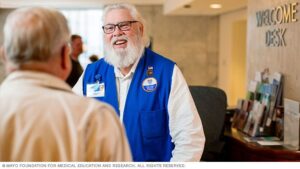
Amazing Desk Operations Specialists
I spoke multiple times with one DOS who I’ll call Ray. I initially asked him 3 questions and each time we came back he called me over and voluntarily shared insights he thought I’d find valuable!
He explained most people who came to him had begun their diagnostic journey with previous doctor(s). Each person and the family members accompanying them were most likely bringing with them at least 3 emotions: some degree of fear, uncertainty, anticipation of frustration.
Mayo Clinic focuses on getting to the root causes of major health conditions before prescribing treatment. Patients come to Mayo:
- With a clear diagnosis that requires specialized treatment
- Without a clear diagnosis
- With differing diagnoses.
Each reason has the potential for fear and uncertainty.
Anticipation of frustration. Ray explained many patients coming to Mayo have experienced frustrations in working with previous doctors, team members, and healthcare facilities. Unless they’ve experienced “Mayo Nice” they are anticipating frustration.
Ray explained that an important component of the role of the DOS is to focus on replacing the patient and family members fears and frustrations with peace of mind and comfort. Checking patients in was only a small part of their responsibilities.
Desk Operations Specialists handled any question asked of them with an answer.
This is huge. They took ownership of each question. If they didn’t have the answer, they found someone who did. They then asked if the patient had any other questions. Until the patient had no more outstanding questions, the Desk Operations Specialist worked with them.
Ray explained the only ‘Mickey Mouse operation’ he’d ever worked for that was operated as intentionally and efficiently as Mayo — was the Mickey Mouse operation. He explained he’d worked at Disney for twenty-two years and Mayo Clinic was at the same level of excellence.
Each employee and volunteer at Mayo knew exactly what their role and responsibilities were. Their process was clear, specific, and each person knew who had responsibility in each touchpoint of service. Expectations and intentional follow-through, set with clarity, were specifically designed to reduce fear, frustration, uncertainty.
How would you feel about change if each component was intentionally designed to provide clarity, understanding and peace of mind?
What I Learned About Caregiving
Caregiving is a single word with an almost unlimited number of definitions and applications. Each diagnosis has its own complexities, differences in progression, complications. Each personal experience is different. Each journey is different. Each individual has their own perspective, emotions, and capacity with the responsibilities of their caregiving journey.
For many years I’ve spoken about the importance and value of massive acceptance and radical presence in our journey as caregivers. Accepting 100% where we — and our care receiver — are. Staying present in each moment, focusing on what is, not what we wish it was/wasn’t or what we fear it may/may not be. The Mayo team members exemplify this.
Each person we spoke with focused on us 100%. We were the only thing important to them when we were together. They met us where we were at. Some patients and their families came in and were visibly upset/frustrated. The Desk Operations Specialists listened. They didn’t defend or justify. They asked quality questions, listened to each answer, clarified them, took action, and ensured each person was satisfied before moving on.
I watched the power of this visibly calm people — including my friend, reassure them, and/or give them clarity when they anticipated confusion. This is what we, as caregivers, work to do for our loved ones.
When we arrived, my friend had an inconsistent, unclear diagnosis and many unanswered questions. With each question asked, she was given answers she could understand and encouraged to ask any follow-up questions. There were times we came back to our hotel room and were discussing what she had learned. New questions came up for her and she was able to contact someone immediately to get an answer. When she received clarity on her diagnosis and the plan for her treatment, each step was carefully explained, either by her doctor or a supporting team member, providing peace of mind.
 |
Mayo Clinic doctors and their team members are united in care. |
Caregiving is a perfectly imperfect journey. We want the best for our care receiver and often don’t know what that looks like from moment to moment, much less day to day. We definitely don’t always know the answers. The more we realize it’s not as important for us to have the answers as it is to be connected with — and whenever possible surrounded by — people who want to help us, the more we stay balanced and supported, the more fully we are able to stay present with our care receiver, meet them where they are at, and be a calming presence for them.
What would our caregiving journey be like if we continuously felt supported, even in uncertainty?
The components of the Mayo Clinic culture don’t need to be written anywhere for people to know what they are; they are exemplified by employees, volunteers, and supporting business employees. The respect Mayo Clinic has for intentionally navigating changes empowers people to shift from fear, uncertainty, and frustration to hope, potential, and possibilities. The sincerity of the perspective of caregiving by each Mayo employee and volunteer, invites calm.
What does ‘Mayo Nice’ look like for you?

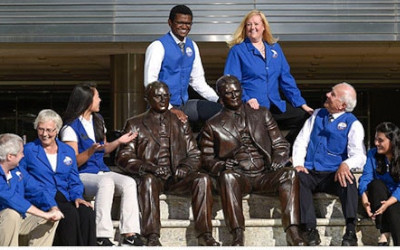

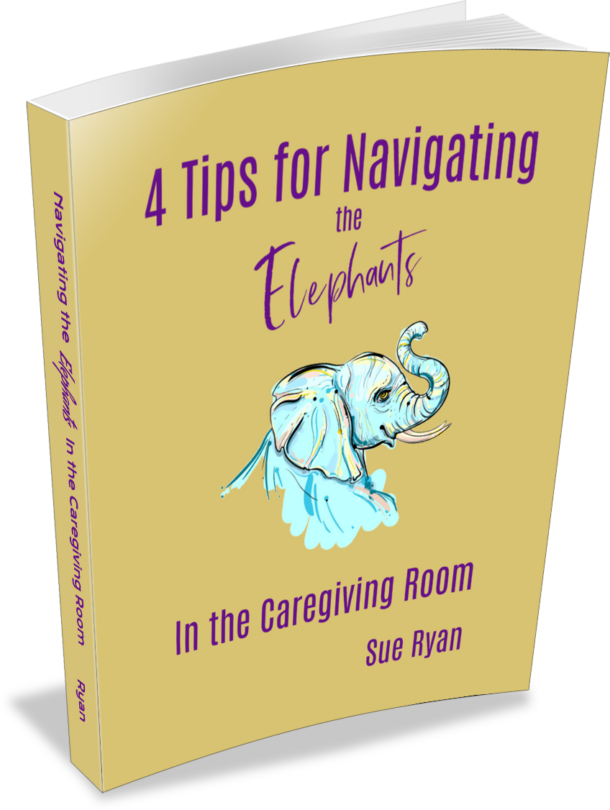

0 Comments